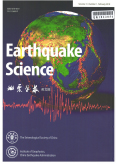- 钛学术文献服务平台 \
- 学术期刊 \
- 基础科学期刊 \
- 天文学、地球科学期刊 \
- 地震学报(英文版)期刊 \
Joint analysis of b-value and apparent stress before the 2011 Mw9.0 Tohoku-Oki,Japan earthquake
Joint analysis of b-value and apparent stress before the 2011 Mw9.0 Tohoku-Oki,Japan earthquake
基本信息来源于合作网站,原文需代理用户跳转至来源网站获取
摘要:
Detecting tempo-spatial changes of crust stress associated with major earthquakes has implications for understanding earthquake seismogenic processes.We conducted a joint analysis of b-value and apparent stress in the source region before the March 11,2011 Mw9.0 Tohoku-Oki,Japan earthquake.Earthquakes that occurred between January 1,2000 and March 8,2011 were used to estimate b-values,while source parameters of events with magnitudes of Ms5.0-6.9 between January 1,1997 and March 8,2011 were used to calculate the apparent stresses.Our results show that the average b-value decreased steadily from 1.26 in 2003 to 0.99 before the Tohoku-Oki mainshock.This b-value decrease coincided with an increase in the apparent stress from 0.65 MPa to 1.64 MPa.Our results reveal a clear negative correlation between the decrease in b-value and increase in apparent stress,which lasted for approximately eight years prior to the 2011 mainshock.Additionally,spatial pattern results of the relative change in b-value show that the area associated with drastic b-value decreases(25%or greater)was concentrated near the 2011 mainshock epicenter.The joint analysis of b-value and apparent stress provides a promising method for detecting anomalies that could serve as potential indicators of large earthquakes.

推荐文章
利用流动GPS测定2011年日本Mw9.0地震远场同震位移
流动GPS
约束解算
同震位移
日本Mw9.0地震
2011年日本MW9.0强震对天津地区地壳运动的影响分析
GNSS
日本9.0级地震
天津地区
时间序列
同震位移
日本Mw9.0强震动观测与记录初步分析
日本Mw9.0地震
强震动记录
衰减
反应谱
日本Mw9.0级地震海啸数值模拟与启示
日本Mw9.0级地震海啸
数值模拟
海啸防灾减灾
内容分析
关键词云
关键词热度
相关文献总数
(/次)
(/年)
引文网络
引文网络
二级参考文献 (0)
共引文献 (0)
参考文献 (0)
节点文献
引证文献 (0)
同被引文献 (0)
二级引证文献 (0)
2021(0)
- 参考文献(0)
- 二级参考文献(0)
- 引证文献(0)
- 二级引证文献(0)
引文网络交叉学科
相关学者/机构
期刊影响力
地震学报(英文版)
主办单位:
中国地震学会
出版周期:
双月刊
ISSN:
1674-4519
CN:
11-5695/P
开本:
16开
出版地:
北京民族学院南路5号(北京8116信箱)
邮发代号:
创刊时间:
1980
语种:
eng
出版文献量(篇)
1366
总下载数(次)
0
期刊文献
相关文献
推荐文献
- 期刊分类
- 期刊(年)
- 期刊(期)
- 期刊推荐
力学
化学
地球物理学
地质学
基础科学综合
大学学报
天文学
天文学、地球科学
数学
气象学
海洋学
物理学
生物学
生物科学
自然地理学和测绘学
自然科学总论
自然科学理论与方法
资源科学
非线性科学与系统科学
地震学报(英文版)2022
地震学报(英文版)2021
地震学报(英文版)2020
地震学报(英文版)2019
地震学报(英文版)2018
地震学报(英文版)2017
地震学报(英文版)2016
地震学报(英文版)2015
地震学报(英文版)2014
地震学报(英文版)2013
地震学报(英文版)2012
地震学报(英文版)2011
地震学报(英文版)2010
地震学报(英文版)2009
地震学报(英文版)2008
地震学报(英文版)2007
地震学报(英文版)2006
地震学报(英文版)2005
地震学报(英文版)2004
地震学报(英文版)2003
地震学报(英文版)2002
地震学报(英文版)2001
地震学报(英文版)2000
地震学报(英文版)1999
地震学报(英文版)2021年第6期
地震学报(英文版)2021年第5期
地震学报(英文版)2021年第4期
地震学报(英文版)2021年第3期
地震学报(英文版)2021年第2期
地震学报(英文版)2021年第1期

 免费查重
免费查重










